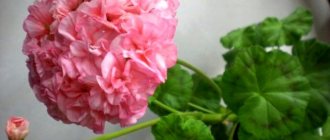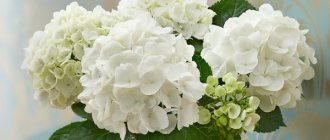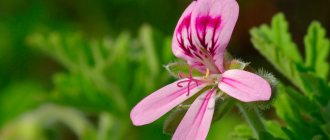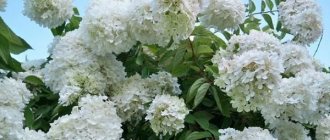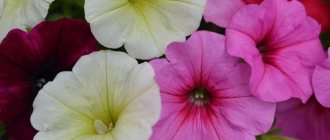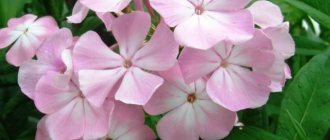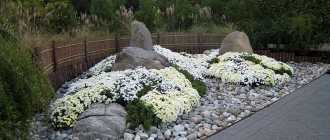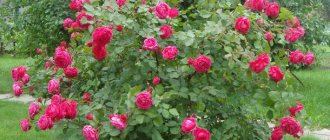Indoor geranium: description
All indoor geraniums can be divided into two groups:
- Blooming, distinguished by beautiful flowers.
- Fragrant, with inconspicuous flowers and fragrant leaves.
The root of geranium is often branched, in some species it is taprooted. The stem can be erect or creeping (in ampelous plants). The leaves are dissected or lobed, less often pinnate, covered with small fine hairs. The color can be monochromatic, zonal, green of varying intensity, with a grayish, red or blue tint. All of them have long petioles.
The flowers are collected in inflorescences of the brush, each of them consists of 5 or more rounded petals of red, pink, purple, white. In some varieties they are marked with bright contrasting spots.
Geranium blooms almost all year round.
To do this, she needs to provide a sufficient amount of light and nutrients. Fruit boxes are formed from the flowers. To many, they resemble the shape of a crane's beak. The plant owes this similarity to several popular names that have taken root in different countries: “crane bird”, “stork’s nose”. Inside the fruit there are quite large seeds.
Trending Pilaf with chicken and shrimp
Geranium varieties of hybrid origin
These are varieties of artificial origin, bred by breeders based on the varietal characteristics of other, natural, species. Most often they are highly decorative, so they are used to decorate garden compositions and for growing at home.
Blue Blood
Geranium diseases, geranium leaves turn yellow and dry - what to do?
This is one of the most popular types of pelargonium, characterized by soft purple flowers with five petals. Brief description of the plant:
- The height of the stem is 0.5 meters.
- The flowers are large and purple. The veins on the petals are clearly visible.
- The leaves are small and pubescent.
- Blooms from early June to the last week of August.
- It needs care: regular watering, fertilizing with fertilizers for flowering ones (or special complexes for geraniums); when growing outdoors, it is better to mulch the bush to get rid of weeds and pests.
Note! Blue Blood is characterized by increased frost resistance, which allows it to be grown in cold winter conditions.
Faye Anna
This hybrid is also not afraid of cold, has a low stem - no more than 19 cm and pink flowers with a white core. Therefore, you can find the name “two-color geranium”. Flowering lasts from July to the end of August, during this period the usual green leaves become rich red, retaining the classic color option only along the edges.
Types of indoor geranium
The most popular and beautiful types of indoor geranium:
Unicuma hybrids have highly dissected, very fragrant leaves. The flowers are large and beautiful, but smaller than those of the Royal one. Miniature and dwarf varieties do not require pruning. They bloom profusely.
Based on the shape of the flower, several groups of zonal geraniums can be distinguished:
- Rosaceae with flowers resembling roses.
- Cactus-shaped with petals twisted in the shape of a cone.
- Star-shaped with pointed petals.
- A group of carnation flowers with petals serrated along the edges stands out.
- Succulents are a special type of geranium. The stems of the plants are intricately curved. Some varieties have thorns.
Pelargonium Unicums (Unique Pelargonium)
Hybrid plants obtained from royal and brilliant pelargonium began to be called unique. This group belongs to the oldest varieties, although it is not so easy to find plants in gardeners’ collections.
Although the flowers of this variety, as in the photo of indoor geranium, are similar to the flowers of royal plants, they are much smaller. But the foliage is often dissected, corrugated, and also has a pleasant smell.
For example, the greenery of the geranium variety shown in the photo called Paton's Unique has a sweetish fruity aroma.
Reproduction
Indoor geranium is propagated by:
- By seeds, but this method does not always guarantee the repetition of the maternal properties of hybrids.
- By cuttings.
Seeds are sown in soil prepared from equal parts of peat, sand and a double portion of turf soil. The main part of the soil mixture is placed in a container, at the bottom of which there is a drainage layer. Sow the seeds over the surface at a distance of 2 cm from each other, then cover the remaining soil with a thin layer. Moisten with a spray bottle.
Cover the dishes with glass or film and keep them warm (temperature about 20°C). Every day they ventilate by removing the glass and shaking off any drops from it. When the first seeds germinate, remove the cover and lower the temperature (you can place it on the windowsill, where it is lower than in the rest of the room).
For the next 2 months, the seedlings are watered, waiting until they have 2 true leaves. Plants are planted in separate small-diameter pots. To get a beautifully shaped plant, pinch the top after the 6th leaf. When sowing seeds collected with your own hands, they are first scarified. To do this, you can grind them with sandpaper.
Geraniums can be propagated by cuttings almost all year round, but in the spring roots are formed more actively.
They take a cutting and leave it in the air for several hours for it to take root. Planted in a container with loose soil or coarse sand. They don't cover. When the cutting takes root, it can be transplanted into another pot.
Most often, cuttings are rooted in a different way. They tear off the lower leaves, place the cutting in a glass of water and wait for roots to form. Then they are planted in a pot.
The soil for growing indoor geraniums is not very fertile. Otherwise, the plant will have many leaves but few flowers. The pot for geraniums should have enough holes to drain excess moisture. A layer of drainage is placed on the bottom of the dish: expanded clay, pebbles, polystyrene foam.
Water as the soil dries out. In winter, in a cool room, watering is carried out a couple of times a month. If the plant is in a warm room, moisten it more often. Plants that were planted in open ground are hidden indoors at the beginning of autumn. They do not tolerate transplantation well. The root system is not able to hold a large amount of soil, so the roots are exposed.
To make geranium easier to transplant, the branches are pruned, limiting their height.
Cut tops can be used for propagation. For the winter, leave a stem on which no more than 7 leaves grow. Remove shoots growing from leaf axils. Leave those that grow from the root. Break off shoots after every 5 leaves. Do not prune geraniums in December and early January. Anti-aging pruning is carried out, leaving 5 buds on the shoot.
What you need to know about geranium?
Basic requirements for long flowering geraniums:
- It can bloom all summer and autumn until winter if the flowerpot with it is placed on a window on the south side
- Loves direct sunlight
- In summer, geranium grows well and blooms at room temperature, in winter it has a dormant period, at this time we water it rarely and keep it in a cool place with a temperature of about 15 degrees Celsius
- In summer, water geraniums abundantly and often, as soon as the soil dries on top.
- We feed the flower once every 2 weeks with complex mineral fertilizer for flowering, starting from the end of March and ending in mid-November
- In autumn we prune the plant, leaving shoots with 6-7 leaves
- For abundant flowering in spring and summer, pinch out young shoots after 4-5 leaves have grown
- Geranium can reproduce by shoots and seeds
Attention: You can prepare geraniums for flowering when there is a lot of sunlight, at least 4-6 hours a day.
Use of the flower
Geranium is used for landscaping an apartment. But in the spring, when the threat of return frosts has passed, it is better to plant it in a flowerbed. All summer it will delight with lush flowering.
Read also: Peony evasive (Maryin root): botanical description and medical use
Geranium leaves are used in salads or for baking. Used as a seasoning. This largely depends on the variety of geranium and the personal preferences of the owner. Geranium leaves are used to scent clothes in closets.
Scented-leaved Pelargonium
It was the smell of crushed geranium leaves that attracted people’s attention to this plant. Until the century before last, the main attention when selecting indoor geraniums was paid not to the beauty of the flowers, but to the aroma, because the plants served as “living deodorants.”
Similar varieties and hybrids of fragrant geranium are still popular today. They will not amaze with their bright flowering or the shape of the inflorescences, but they are used for flavoring culinary dishes and for household fragrance when storing bed linen or outerwear.
Depending on the type and variety, as in the photo, indoor geranium, its leaves can smell like all kinds of fruits, mint and roses, nutmeg, carrots or pine needles.
Description of the plant
Geranium got its name because of the shape of the fruit, reminiscent of a crane's beak (translated from Greek geranios - “crane”). In total, the family includes more than 400 species. In the wild it is represented by herbs and shrubs.
Cultivated varieties are very diverse, among them there are miniature (less than 12.5 cm in height) and vigorous (up to 1 m). They are used both for outdoor gardening and landscape design, and for home growing.
In many varieties, flowers are collected in lush inflorescences located on vertical peduncles. Flowers can be simple or double.
The leaves have a characteristic aroma reminiscent of lemon or mint.
Features of the plant and its characteristics
Indoor geranium, or in other words, pelargonium, is a representative of the Geranium family. This plant is easy to care for and propagate. There are several most common types of geraniums:
- fragrant: does not bloom profusely, but is characterized by a strong odor that comes from the leaves;
- royal: blooms with bright, large flowers, but there is practically no smell;
- zonal: universal, good both in indoor culture and in flower beds;
- ivy-leaved: ampelous form, grown in flower pots;
- unique: a small but ancient group of flowers, which belongs to tall, forms with a woody stem;
- Pelargonium-angel: medium-sized plants, reminiscent of pansies, with fragrant foliage, growing “in the open air”.
Tulip geranium differs from other members of the family by its flowers, similar to an unopened tulip . The flower is not large, only a centimeter. Separately, it would not look so impressive, but on each stem there is a fluffy inflorescence formed by 30-50 flowers. It's like one luxurious bouquet.
Flowers of delicate or rich color: from pink to burgundy. The color of the inner surface of the petal is brighter, and the veins are visible on the outer surface. The leaves are also not quite ordinary; they are hard and shiny. Plant height can vary significantly: from 30 to 70 cm.
The origin story of the plant is not entirely ordinary. In America, Boston, there is Andrea's nursery. In 1966, it was there that the first tulip-shaped variety was bred and presented to the general public. According to one version, this is a species mutation. According to the other, it is the result of hybridization (obtained by crossing two different varieties).
The first variety with such flowers was named Patricia Andrea . Over the course of several years, several more varieties were developed that were named after the women of the breeders' families: Patricia, Carmen, Victoria, Lilian and Linea.
Main types
Homemade geranium is divided into two main groups: beautifully flowering and fragrant varieties.
The former are more popular due to their spectacular appearance. They are represented by several varieties, often not isolated, but intersecting with each other. In fact, by species in this case we mean a characteristic feature inherent in a plant: it can relate to the characteristics of leaves or flowers, the height of the bush, etc. Many varieties have 2-3 such features at once, which means they belong to all relevant groups.
First, let's look at beautifully flowering types of geraniums.
The most popular and largest group. Its peculiarity is the presence of a red or brown area on the leaves. It usually has the shape of an uneven circle. The more light a flower receives, the more pronounced the contrast.
The leaves themselves are round, slightly wavy, often slightly pubescent, with a characteristic odor. The stem is erect and usually needs shaping. Without proper pinching, some varieties can grow up to 1 m in height.
The flowers of this variety are simple (5 petals), semi-double (6–8 petals) and double (more than 8 petals).
Rosaceae
As the name suggests, the flowers of this geranium resemble miniature roses. Usually they are terry or densely double. May have a smooth or wavy edge. Petals can be either single-colored or two-colored, with a lighter outer side or a smooth gradient from the edge to the base. Lush inflorescences, up to 20 pcs.
Tulip-shaped
The flowers of this variety remain semi-closed throughout the entire flowering period, which is why they resemble small tulips. They themselves are small, up to 1.5 cm in diameter, but they form very lush inflorescences, sometimes up to 40 pieces. Most often red or pink, but there are a few white varieties. It is believed that the latter are more difficult to care for and less amenable to shaping.
Sometimes flowers can “spoil”, that is, open completely.
The first representatives of this group appeared in the first half of the 19th century.
The variety is distinguished by strongly dissected leaves that exude a light spicy aroma. Stems and shoots are prone to woodiness. Flowering is abundant. The flowers are small, the petals often have dark spots or veins, like royal geraniums. The petals are most often red, becoming lighter towards the core. Less commonly they are white or pink.
Most varieties are tall and suitable for outdoor growing.
A kind of miniature royal geranium - the height of the bush of this species does not exceed 35 cm. Flowering is abundant. The flowers are round and rather small. They can be purple, white, pink, orange. There is usually a spot on the petal, giving these flowers a pansy-like appearance. The upper petals are wide. The lower ones are narrower, often forming a “fan”.
The stems are thin, becoming woody over time. The leaves are small, with a crenate edge and a pronounced scent.
Despite its external fragility, the variety is very hardy. In partial shade it becomes ampelous; in the sun it forms a strong, erect bush. It blooms so profusely that sometimes the leaves are not visible under the flowers.
Like royal geraniums, “angels” are often infested by whiteflies.
Variegated
Varieties of this group are most valued for their decorative leaves. It can be expressed in different ways: white spots, a wide border, contrasting veins, etc. Some varieties have rounded leaves, others have openwork. The tricolor varieties are very beautiful, for example Golden Brilliantisum - the inside of the leaf is green, there is a wide yellow border around it, and a bright orange circle, as if circling the center, is layered on both parts.
However, in order to maintain their decorative appearance, these geraniums must receive abundant lighting: in winter, even with additional lighting, the leaves may completely or partially lose their decorative effect. A number of variegated varieties bloom rarely or not at all.
cactiformes
The variety is distinguished by long, elongated (sometimes even needle-like) and often twisted petals, which makes the inflorescences look shaggy. Flowers can be one-color or two-color. The popularity of this group peaked at the end of the 19th century; now it is quite rare.
Ivy-leaved
The group is so named because of the ivy- or star-shaped leaves. It is also called the thyroid. This variety includes most ampelous varieties, that is, those whose stems creep or fall down. They are often grown in hanging baskets and used for outdoor landscaping. In landscape design, such geraniums are sometimes grown as ground cover. The length of the shoots can reach 1 m.
Interesting on the topic:
Momordica
Mar 5, 2022
Whose saffron is better: a unique spice from Imeretian...
Mar 4, 2022
The leaves are without pubescence, dense, smooth, glossy and very even, which is why they are sometimes even confused with artificial ones.
Ivy-leaved varieties are often variegated. Flowers can be simple or double, up to 5 cm in diameter.
Dwarf
This group includes plants with a height of 12.5 to 30 cm. Flowering is most often abundant, long-lasting and lush; in some varieties the caps even look disproportionately large compared to the bush.
Read also: Begonia ever-flowering: description of varieties, cultivation and care at home
Many dwarf varieties do not need shaping, as they form a neat bush even without pinching.
Royal
The variety is so named for its particularly large (5–7 cm) and attractive flowers. Most often, they have a multi-color contrasting color: darkening or lightening towards the core, speckled, with pronounced veins, etc. The shape is a little reminiscent of a pansy - the petals are layered on top of each other like a fan. The edge of the petal can be simple, corrugated or wavy.
The height of the bush most often ranges from 30 to 60 cm.
The leaves are usually dense, folded, with a jagged edge. The smell is almost not pronounced, which some consider a plus.
Flowering is shorter than other varieties: with proper care, it lasts a maximum of 3–4 months.
This variety is very capricious and sensitive to care: due to unsuitable conditions, the flower may die or at least drop its buds. Royal geranium is an indoor crop that does not respond well to growing in open ground.
Now let's get acquainted with the second large group of geraniums. Although it is not as popular as the beautiful flowering one, it also has many fans.
The main feature inherent in this species is the presence of tiny glands on the stems and leaves that emit aroma at the slightest touch or vibration of the air. If the selection work on beautifully flowering geraniums concerned the appearance, then in this case the work was mainly on the smell.
At the moment, there are more than 150 varieties, each of which has its own special aroma, such as rose, lemon, strawberry, apple, nutmeg, cinnamon, etc.
The smell of fragrant geranium repels parasites and kills germs. Sometimes its leaves are used to cover clothes to protect against moths.
Where the climate allows, this plant is grown on plantations for the industrial production of essential oil. It is used in cosmetology, cooking and medicine.
The flowers are small, solitary, most often pink or purple. Some varieties bloom profusely, others bloom rarely and little. The leaves are most often carved and quite beautiful.
Contraindications to taking fragrant geranium products
Fragrant geranium has many positive qualities, but there are also negative ones.
Who should not take folk medicine from fragrant geranium?
- People with high blood viscosity
- People with low blood pressure
- Children under 12 years old
- Pregnant women
- Women who are breastfeeding
- For people of old age
- People with chronic diseases of the stomach, liver, and kidneys during exacerbation
- For varicose veins
- People with bronchial asthma
- For people with individual intolerance to the smell of fragrant geranium
If you buy fragrant geranium and place it on the window in your room, it will kill all harmful microorganisms and you will get sick less. Beautifully flowering geraniums do not have medicinal properties, but they bloom very beautifully.
Indoor geranium: types and varieties with photos and names
From early childhood I remember that I was surrounded by flowers - in the house, in the front garden, there were many beautiful and bright plants. But the most favorite flower of my grandmother, who was the main flower grower in the family, was geranium.
This is not surprising; the spectacular and unpretentious inhabitant of our window sills, balconies, and street flower beds will not leave any person indifferent.
When I had a child, there was a noticeable lack of money, and I decided, without bothering myself too much, to earn a little extra money. Get serious about growing beautiful plants. I chose geranium, or as it is also called, pelargonium.
I want to share my views on this flower, thoughts, and not very much experience.
A worthy decoration for any windowsill: peony geranium
Peony or terry geranium is a wonderful representative of the pelargonium family.
The decorative nature of the flower allows it to decorate the most sophisticated interiors. The long flowering period and relative ease of care make it possible for even an inexperienced gardener to grow this beauty.
In this article we will look at the features of peony geranium, find out how to grow a flower, and how to care for it.
What are the benefits of geranium?
- Firstly, by correctly and carefully selecting varieties (and even I can name about fifty of them without hesitation), there are luxurious flowers in the house. Moreover, these flowers actively grow and do not fade in vases with water;
- Secondly, you can always take a leaf or cutting to plant a new plant without the risk of harming the mother flower;
- Thirdly, crossing varieties in order to obtain new shades is a fascinating activity that does not take much time. There is an opportunity to calmly manage household chores and play with the baby;
- Fourthly, there is always an original bright gift on hand for loved ones. This is also a real financial saving.
The list can be continued with many more points, but for me, my passion for plants has become my main hobby and a source of good income.
How to make money growing geraniums
I have not yet put flower growing on a large scale, on an industrial scale. For now I have enough trouble with the baby, and I don’t have time to build greenhouses and greenhouses. In addition, you need strength, money, and again the same time to draw up various legal documents.
You can sell ready-made plants in the following ways:
Features of seasonal care
The spring-summer period is when pelargonium actively grows and blooms. She needs a sufficient amount of light, moderate warmth, regular watering and feeding. In winter there comes a period of rest. Therefore, caring for the plant requires some changes.
Most species require a cool winter with a temperature of +12..14°C. This will allow future buds to form and stimulate lush flowering in the coming season. It is important to provide the flower with additional lighting. Daylight hours should be 10-12 hours. Pelargonium needs to be put into dormancy mode gradually. Starting in the fall, gradually reduce watering and stop fertilizing.
Growing pelargonium
Many fans of these flowers argue that geranium and pelargonium are different plants belonging to the same family of shrubs and herbs. Their homeland is warm southern countries. But let this issue of plant division concern biologists. My flowers grow successfully in the middle zone.
My pets feel good both on the windowsills and in the open ground, on the site, and even outside the gates of the house. Geranium is cold-resistant (although it is classified as a heat-loving plant). It is perennial and beautifully flowering.
Despite such characteristics, my favorite requires attention.
Tulip geranium - what kind of flower is it, what family does it belong to?
The flower belongs to the Geranium family. Tulip-shaped varieties have several differences from ordinary geraniums. The inflorescences of the species consist of numerous flowers that look like tiny tulips.
On a note! There is a misconception that tulip geraniums are very difficult to care for. Flower growers prove the opposite. Compliance with basic rules of care will preserve the individual characteristics of the species.
Brief description, history of origin and selection
Tulip-shaped geranium was bred by breeders. The first mention of the species was found in the editorial of a gardening magazine published in 1966 in Boston. In Europe, geranium first appeared only 10 years later. Flower growers believe that this species was obtained as a result of a natural mutation of other varieties.
Plant care
The flower does not require special conditions for growing, but you need to pay attention to the following points: regular watering, good lighting and air temperature.
I live in a private house and in winter I keep pots of flowers in the house. In the spring, I plant young plants in flower beds, in the front garden, “potted” plants intended for sale, and take them outside. When there is a danger of frost, I cover the plants with film at night.
Landing
In order for the plant to fully grow and develop, you need to know the main features of planting a crop :
- choice of location;
- illumination;
- temperature;
- soil composition.
Lighting and location
In order for the mini-bush to bloom for a long time and beautifully, carefully choose a well-lit place. With sufficient light, the plant will have bright not only petals, but also leaves. If there is a lack of light, the decorative appearance of the flower will fade : there will be fewer inflorescences, and the leaf blade will turn pale.
You need to choose a place for pelargonium so that there is no direct sunlight. At midday, the flower needs to be shaded. In winter, so that the plant does not lose its decorative appearance, it will need additional lighting using lamps.
For the correct formation of the crown, the flower pot should be turned to the window in different directions. Then the sun's rays will be able to reach all parts of the plant, and it will begin to grow evenly.
Soil requirements
Dwarf pelargonium does not have any special requirements for soil composition . It is important to provide the flower with good drainage to prevent moisture stagnation in the pot.
Soil with a neutral or slightly alkaline reaction is best suited for the plant. If the soil is acidic, then it is necessary to add ash to it.
To prepare the soil mixture, you can mix the following components in equal proportions::
- humus;
- leaf soil;
- turf;
- river sand.
Reproduction
Geranium is grown equally successfully both from cuttings and from seeds. Proper drainage and fertilization of the soil is the key to success. This is especially important if the flowers grow in pots. Of course, every weed is immediately removed, even from the pot.
I would like to dwell on the issue of geranium propagation. It can be done in two ways:
- Seed, not very popular among gardeners. However, if you want to breed varieties for those who like to experiment, it is most correct;
- Cuttings, which, in turn, are of two types.
I never thought about the names of flowers, of course, until the time when geraniums became my hobby. I know that there are more than two hundred species of these beautiful plants in the world. At home I grow several varieties - Angel, Terry, Pink. I do various experiments with these plants; they have taken root well in my house and garden.
Read also: Shield plant: planting and care, types of fern and varieties
You shouldn’t have many varieties; it’s better to engage in breeding, create your own varieties, and provide yourself with high-quality seed material. To this I would like to add that geranium seeds are not difficult to sell if you really seriously devote yourself to such a hobby.
When I began to seriously engage in floriculture, I asked what benefits and harm my favorite plant could bring. I was prompted to do this by caring for my little son.
Beautiful large-flowered geranium, red, pink or purple, after some time of inhaling its aroma, will relieve headaches. If you roll the leaves into tubes and put them in your ears, the effect will increase significantly. Bright red pelargonium is most effective.
Description, history and cost
Dwarf pelargonium is a variety of pelargonium that was obtained artificially as a result of targeted selection. In the process of breeding work, a compact ornamental bush was obtained that does not require molding pruning.
In addition to their attractive appearance, mini pelargoniums have healing properties and a delicate aroma. The smell that flowers emit improves mood and cleanses the air of pathogenic microflora.
You can buy dwarf pelargonium seeds for 125-150 rubles, and cuttings for 300-700 rubles.
Main types
This indoor plant is easily recognized by the original color of the leaves. The leaf blade of this geranium has a green tint with a brown border. A group of indoor flowers called zonal geraniums belong to the so-called “grandmother flowers”. It is very widespread and includes thousands of varieties, among which there are those that you may have long been accustomed to seeing on your window or in a friend’s house.
The zonal category of pelargoniums includes not only shrubs with edged leaves. Separation is also carried out according to flowers (plants with simple, semi-double or double inflorescences are distinguished). You can safely buy these types of home pelargonium for your home, even if you have not yet grown this flower. There are no difficulties in care, and the flowering of this group of plants is quite long.
Rosaceae
If you are interested in truly enchanting varieties of pelargonium, you should pay attention to rosaceae. This group gets its name from the key features of the inflorescences. Their petals, and indeed the shape of the flower, are very reminiscent of garden roses.
If you compare a flower called rose geranium with a miniature English rose, it will not be so easy to find the differences, their buds are so similar to each other. Interestingly, this category of plants was actively grown in Great Britain back in the 19th century. However, in Russia, rose-flowered geranium has not yet become widespread.
Tulip-shaped
What is remarkable about this variety of homemade geranium? It has very beautiful buds, similar in appearance to tulips. A key feature of the plant is the fact that during the flowering period the buds do not open completely. Growing such geraniums at home is not too difficult. It is noteworthy that this beautiful hybrid was obtained as a result of spontaneous crossing. However, modern varieties of the plant are replenished with new specimens from this category.
Geranium varieties belonging to this category are distinguished primarily by their beautiful flowers with veins and patterns. The leaves of such a plant are also worth paying attention to, since they are decorative. The leaf blade of pelargonium also has a characteristic aroma, which may differ depending on the variety. Fragrant geranium is more successful in this regard, but fragrant leaves are one of the key characteristics of such pelargonium.
Variegated
cactiformes
Ivy-leaved
Ivy-leaved geranium or pelargonium is a lush and branched plant that produces many flowing shoots.
That is why if you want to decorate your gazebo or porch at home beautifully, feel free to purchase a flower pot and plant such flowers in this container. Geranium buds have bright colors, and the leaves are smooth and have a slight glossy sheen. That is why the variety was called ivy-leaved.
Dwarf
A home greenhouse must certainly include hybrid pelargoniums. Opt for dwarf specimens, and the plant will not need to be pruned at all. Indoor perennial geranium blooms profusely, although the bush itself is miniature. If you are looking for herbaceous plants for outdoor use, dwarf geraniums are not the best option. This floral specimen will look much better on the windowsill next to other house plants.
Royal
The description of royal geranium is also recommended for every gardener to consider. This category of plants has gained wide popularity because they are difficult to miss. Their main advantage is considered to be bright buds of a wide variety of colors: white, pink, red, burgundy, etc. Moreover, the shape of the petals is usually terry or at least wavy. In addition, the shade of the buds is not monochromatic - closer to the core of the flower, the color also includes dark spots.
Pink fragrant geranium is considered an aromatic herbal plant. This flower specimen contains special substances - phytoncides, which are responsible for the production of the characteristic aroma. The smell is especially noticeable if you touch the plant. It is not difficult to care for it - the main thing is to pinch it from time to time. The flower loves this procedure, since there are more shoots on it, and in general a lush shrub is formed.
Diseases and pests
A plant can become sick due to non-compliance with maintenance conditions or improper care. Main reasons:
- lack of sunlight;
- waterlogging of the soil;
- lack of watering;
- dry air and heat indoors;
- cold drafts and low temperatures.
It is necessary to take action if swelling appears on the leaves, the color changes, or they begin to turn yellow and fall off. The lack of flowering should also be alarming. Due to frequent watering, the plant may develop root rot; the first sign is a darkened base of the stems. In this case, the flower will have to be destroyed.
There are few pests that damage the beauty of pelargonium - these are:
- aphid;
- whitefly
Parasites can be found on the underside of leaves, so it is better to inspect the bushes regularly and carefully. Treating pests with insecticidal preparations, which can be purchased in specialized stores, helps.
We invite you to watch a video about diseases and pests of geranium:
It was not for nothing that pelargonium was previously considered the flower of aristocrats - its advantages far outweigh its disadvantages, and the variety of species is amazing. The ease of care is captivating, which is why the plant is one of the most popular among gardeners.

